
L The P (1969) by Scaffold. Art: Ascending and Descending (1960).
A follow-up to yesterday’s post. MC Escher lived long enough to see his work move from curiosities appealing to a small circle of print collectors, through enthusiasm among scientists and mathematicians, to mass acceptance in the late 1960s thanks, in part, to the general vogue for any art that looked weird or far out. New Worlds magazine used Relativity on a cover in 1967, while Thomas Albright writing for Rolling Stone in 1970 introduced a generation of American heads to Escher’s work. A year earlier, another Rolling Stone, Mick Jagger, had tried to persuade Escher to create something for the cover of Let It Bleed; the artist declined but that didn’t stop others using his prints for cover art.
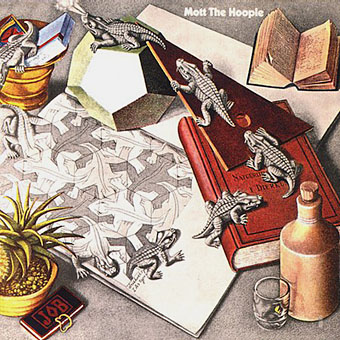
Mott The Hoople (1969) by Mott The Hoople. Art: Reptiles (1943).
Escher’s work is so well-suited to a vinyl sleeve that I’m surprised his lithographs and woodcuts haven’t seen more use. Liverpool group Scaffold beat Mott the Hoople to the first usage by a few months in 1969 (unless there’s an earlier example I don’t know about); L The P is a play on the Scaffold’s big hit, Lily The Pink. As is often the case with these music design histories, things start off well with sympathetic treatments of the artwork then degrade when hamfisted amateur designers take over. I can’t imagine Escher being flattered by some of the later examples. If you know of any others, good or bad, then please leave a comment.
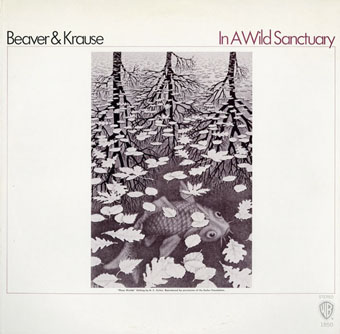
In A Wild Sanctuary (1970) by Beaver and Krause. Art: Three Worlds (1955).
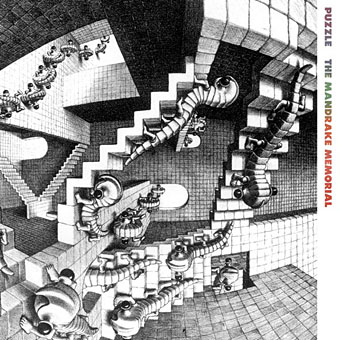
Puzzle (1970) by The Mandrake Memorial. A gatefold sleeve which opened out to reveal the whole of Escher’s House of Stairs I (1951). Inside the gatefold was Curl-up (1951). Design by Milton Glaser who also designed the group’s second album, Medium.
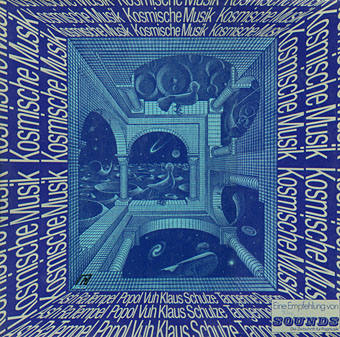
Kosmische Musik (1972) by Various Artists. An Ohr Records music sampler featuring Popol Vuh, Klaus Schulze, Ash Ra Tempel and Tangerine Dream. Art: Other World (front, 1947) and Double Planetoid (back, 1949).
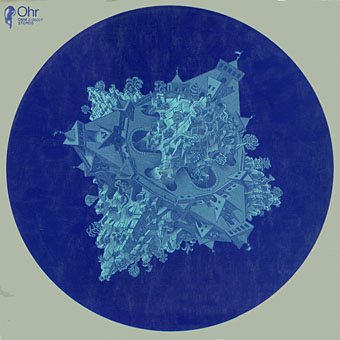

Invisible (1974) by Invisible. Art: Puddle (1952).
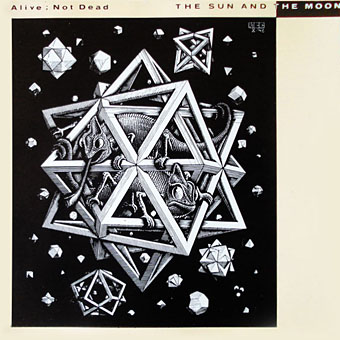
Alive; Not Dead (1988) by The Sun and the Moon. Art: Stars (1948).

Offertorium by Sofia Gubaidulina (1989); Gidon Kremer, Boston Symphony Orchestra, Charles Dutoit. Art: Rind (detail, 1955).

Symphonic Songs by Alphons Diepenbrock (1990); Linda Finnie, Robert Holl, Christoph Homberger, Residentie Orchestra The Hague, Hans Vonk. Art: Phosphorescent Sea (1933).

Locked Inside (1990) by Legend Killers. Art: Bond of Union (1956).

Three Intersecting Plans (sic) (1991) by Gregor Samsa. Art: Three Intersecting Planes (1954).

Obsesión (1992) by La Casa Usher. Art: Eye (1946).

The Complete Piano Music by György Ligeti, Volume 1 (1996); Fredrik Ullén. Art: Circle Limit IV (1960).
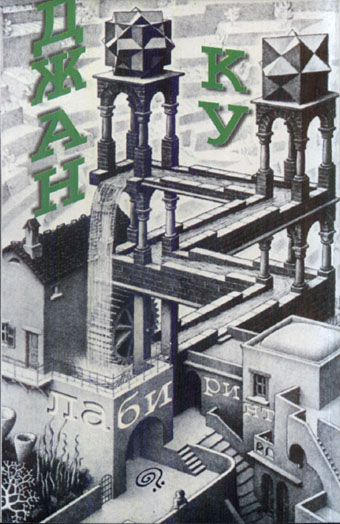
Maze (2000) by Gian Ku (name and title Google-translated so may be wrong). A cassette release. Art: Waterfall (1961).
Elsewhere on { feuilleton }
• The album covers archive
Previously on { feuilleton }
• Escher and Schrofer

There’s probably a post to be done about Escher and covers of philosophy books (David Pears’ The False Prison, Volume 2 and Möbius Strip II and Gilbert Ryle’s On Thinking and an uncredited, clipped and rotated Drawing Hands leap immediately to mind), but I fear I lack the motivation.
Yes, Escher book covers are as limitless as some of his tessellated patterns. My big Escher book points out that science books were using his work for cover illustrations from the 1950s on. I’d thought of following up with a post about Escheresque things–those drawing hands and the Relativity stairs have been imitated many times–but I’ve been too busy this week.
I think my lack of motivation comes from not being able to think of a good use of Escher on philosophy book covers. The Pears is very ugly, and if any field ever called for abstract and/or minimalist design …